University Finance Case Study: Nuclear Power Plant Project Evaluation
VerifiedAdded on 2022/11/11
|10
|1597
|137
Case Study
AI Summary
This case study focuses on the financial analysis of a proposed nuclear power plant project by CS Energy, a Queensland-based electricity generation company. It involves developing a spreadsheet model for cash flow valuation, utilizing capital budgeting techniques, and conducting both quantitative (sensitivity and scenario analysis) and qualitative risk assessments. The study evaluates the project's feasibility, considering factors like foreign investment issues and environmental concerns. A recommendation is provided regarding the project's viability, along with a business proposal intended for the Federal Government to obtain necessary approvals. The analysis highlights the project's potential benefits, including increased electricity capacity for Queensland, while addressing potential risks and ethical considerations related to nuclear power generation and resource utilization. The study also takes into account the company's efforts to protect employees and the environment.
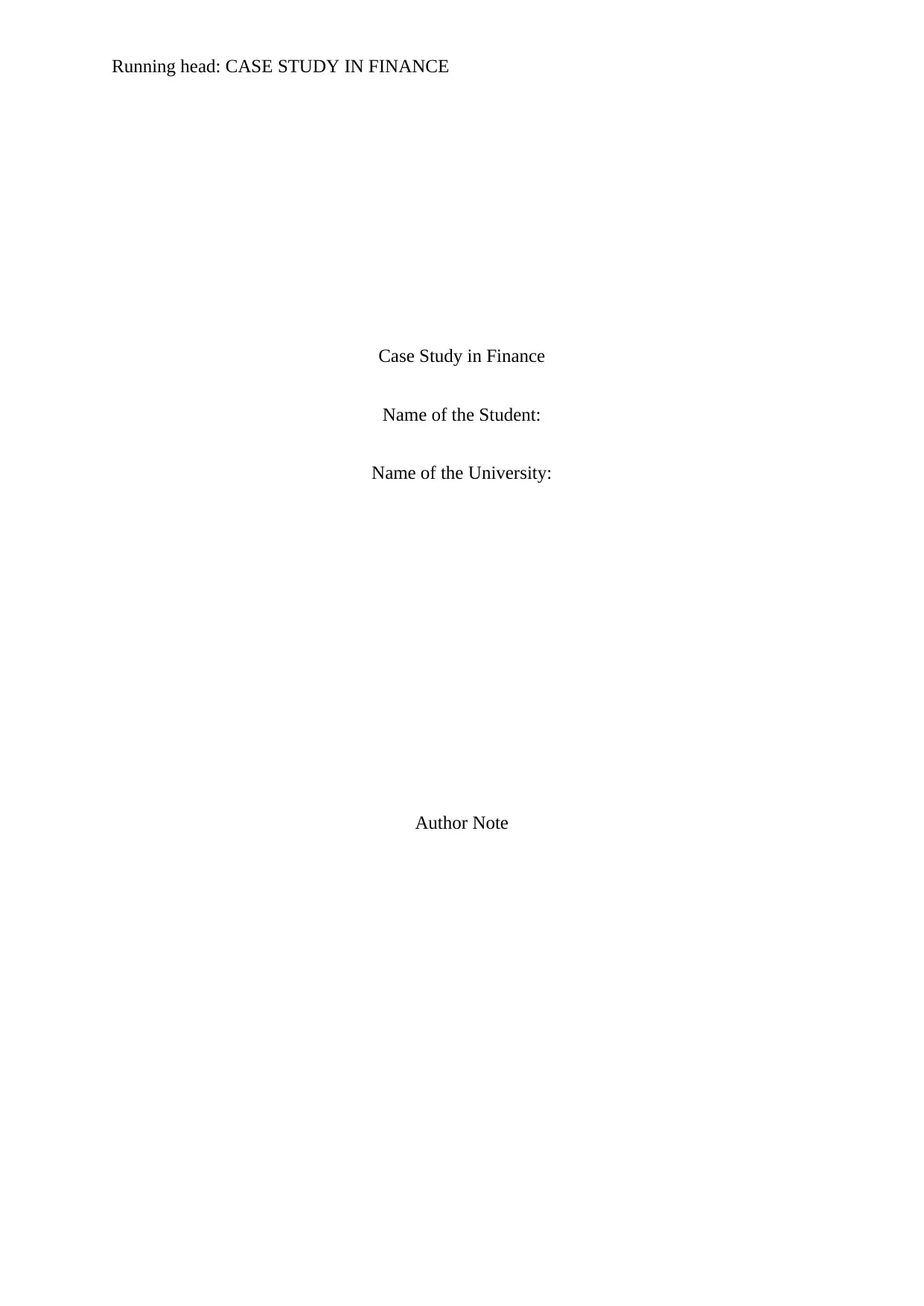
Running head: CASE STUDY IN FINANCE
Case Study in Finance
Name of the Student:
Name of the University:
Author Note
Case Study in Finance
Name of the Student:
Name of the University:
Author Note
Paraphrase This Document
Need a fresh take? Get an instant paraphrase of this document with our AI Paraphraser
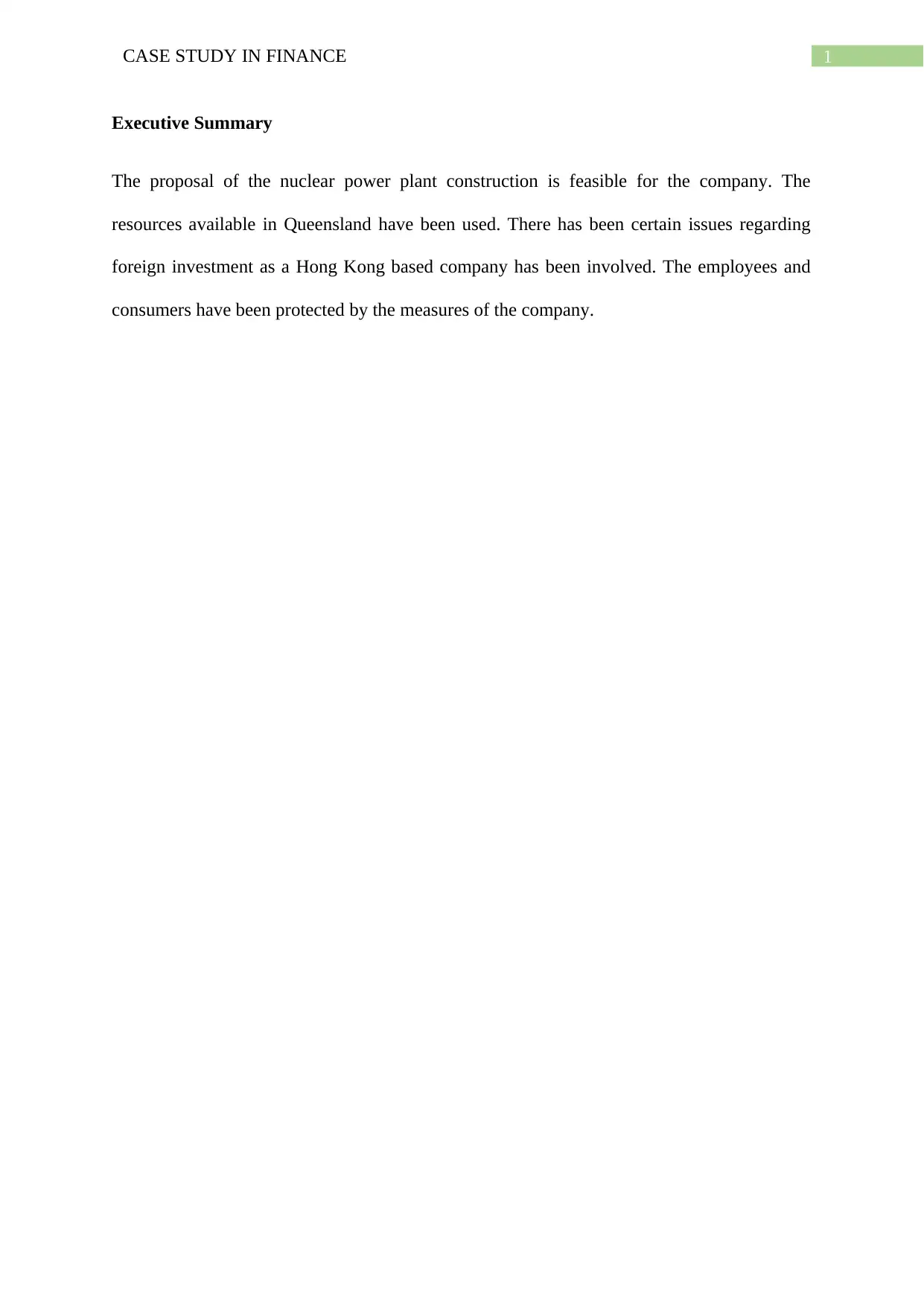
1CASE STUDY IN FINANCE
Executive Summary
The proposal of the nuclear power plant construction is feasible for the company. The
resources available in Queensland have been used. There has been certain issues regarding
foreign investment as a Hong Kong based company has been involved. The employees and
consumers have been protected by the measures of the company.
Executive Summary
The proposal of the nuclear power plant construction is feasible for the company. The
resources available in Queensland have been used. There has been certain issues regarding
foreign investment as a Hong Kong based company has been involved. The employees and
consumers have been protected by the measures of the company.
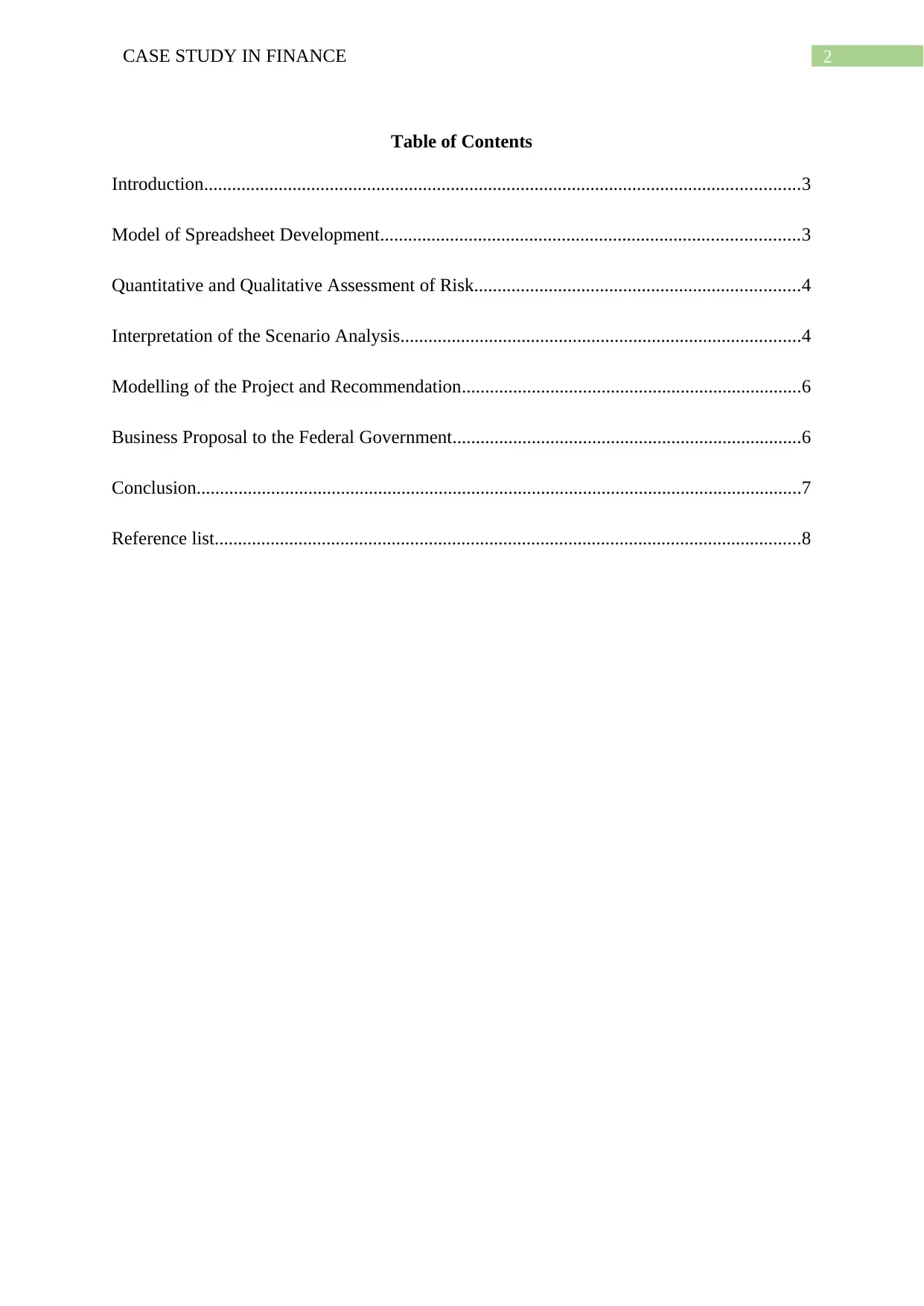
2CASE STUDY IN FINANCE
Table of Contents
Introduction................................................................................................................................3
Model of Spreadsheet Development..........................................................................................3
Quantitative and Qualitative Assessment of Risk......................................................................4
Interpretation of the Scenario Analysis......................................................................................4
Modelling of the Project and Recommendation.........................................................................6
Business Proposal to the Federal Government...........................................................................6
Conclusion..................................................................................................................................7
Reference list..............................................................................................................................8
Table of Contents
Introduction................................................................................................................................3
Model of Spreadsheet Development..........................................................................................3
Quantitative and Qualitative Assessment of Risk......................................................................4
Interpretation of the Scenario Analysis......................................................................................4
Modelling of the Project and Recommendation.........................................................................6
Business Proposal to the Federal Government...........................................................................6
Conclusion..................................................................................................................................7
Reference list..............................................................................................................................8
⊘ This is a preview!⊘
Do you want full access?
Subscribe today to unlock all pages.

Trusted by 1+ million students worldwide
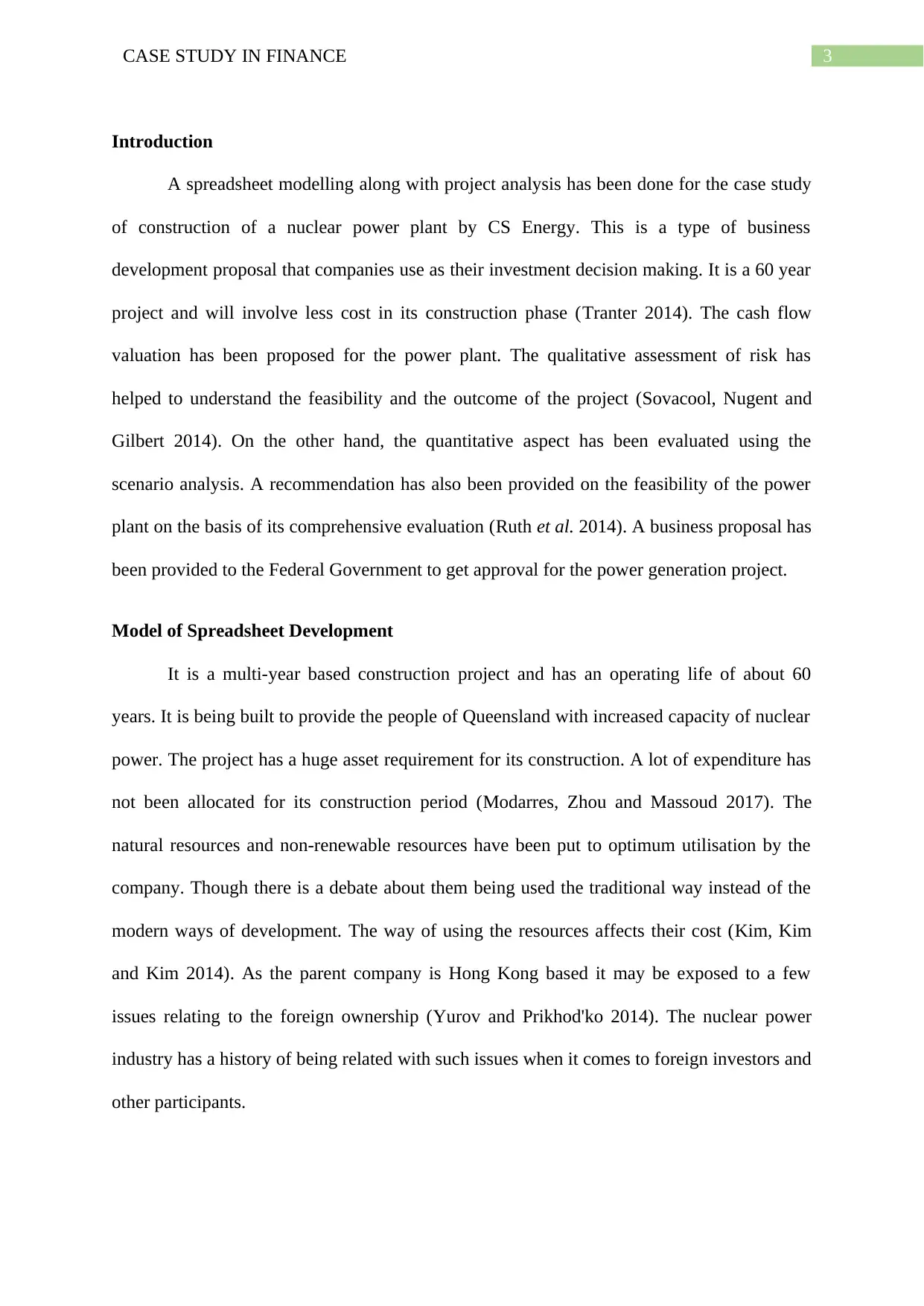
3CASE STUDY IN FINANCE
Introduction
A spreadsheet modelling along with project analysis has been done for the case study
of construction of a nuclear power plant by CS Energy. This is a type of business
development proposal that companies use as their investment decision making. It is a 60 year
project and will involve less cost in its construction phase (Tranter 2014). The cash flow
valuation has been proposed for the power plant. The qualitative assessment of risk has
helped to understand the feasibility and the outcome of the project (Sovacool, Nugent and
Gilbert 2014). On the other hand, the quantitative aspect has been evaluated using the
scenario analysis. A recommendation has also been provided on the feasibility of the power
plant on the basis of its comprehensive evaluation (Ruth et al. 2014). A business proposal has
been provided to the Federal Government to get approval for the power generation project.
Model of Spreadsheet Development
It is a multi-year based construction project and has an operating life of about 60
years. It is being built to provide the people of Queensland with increased capacity of nuclear
power. The project has a huge asset requirement for its construction. A lot of expenditure has
not been allocated for its construction period (Modarres, Zhou and Massoud 2017). The
natural resources and non-renewable resources have been put to optimum utilisation by the
company. Though there is a debate about them being used the traditional way instead of the
modern ways of development. The way of using the resources affects their cost (Kim, Kim
and Kim 2014). As the parent company is Hong Kong based it may be exposed to a few
issues relating to the foreign ownership (Yurov and Prikhod'ko 2014). The nuclear power
industry has a history of being related with such issues when it comes to foreign investors and
other participants.
Introduction
A spreadsheet modelling along with project analysis has been done for the case study
of construction of a nuclear power plant by CS Energy. This is a type of business
development proposal that companies use as their investment decision making. It is a 60 year
project and will involve less cost in its construction phase (Tranter 2014). The cash flow
valuation has been proposed for the power plant. The qualitative assessment of risk has
helped to understand the feasibility and the outcome of the project (Sovacool, Nugent and
Gilbert 2014). On the other hand, the quantitative aspect has been evaluated using the
scenario analysis. A recommendation has also been provided on the feasibility of the power
plant on the basis of its comprehensive evaluation (Ruth et al. 2014). A business proposal has
been provided to the Federal Government to get approval for the power generation project.
Model of Spreadsheet Development
It is a multi-year based construction project and has an operating life of about 60
years. It is being built to provide the people of Queensland with increased capacity of nuclear
power. The project has a huge asset requirement for its construction. A lot of expenditure has
not been allocated for its construction period (Modarres, Zhou and Massoud 2017). The
natural resources and non-renewable resources have been put to optimum utilisation by the
company. Though there is a debate about them being used the traditional way instead of the
modern ways of development. The way of using the resources affects their cost (Kim, Kim
and Kim 2014). As the parent company is Hong Kong based it may be exposed to a few
issues relating to the foreign ownership (Yurov and Prikhod'ko 2014). The nuclear power
industry has a history of being related with such issues when it comes to foreign investors and
other participants.
Paraphrase This Document
Need a fresh take? Get an instant paraphrase of this document with our AI Paraphraser
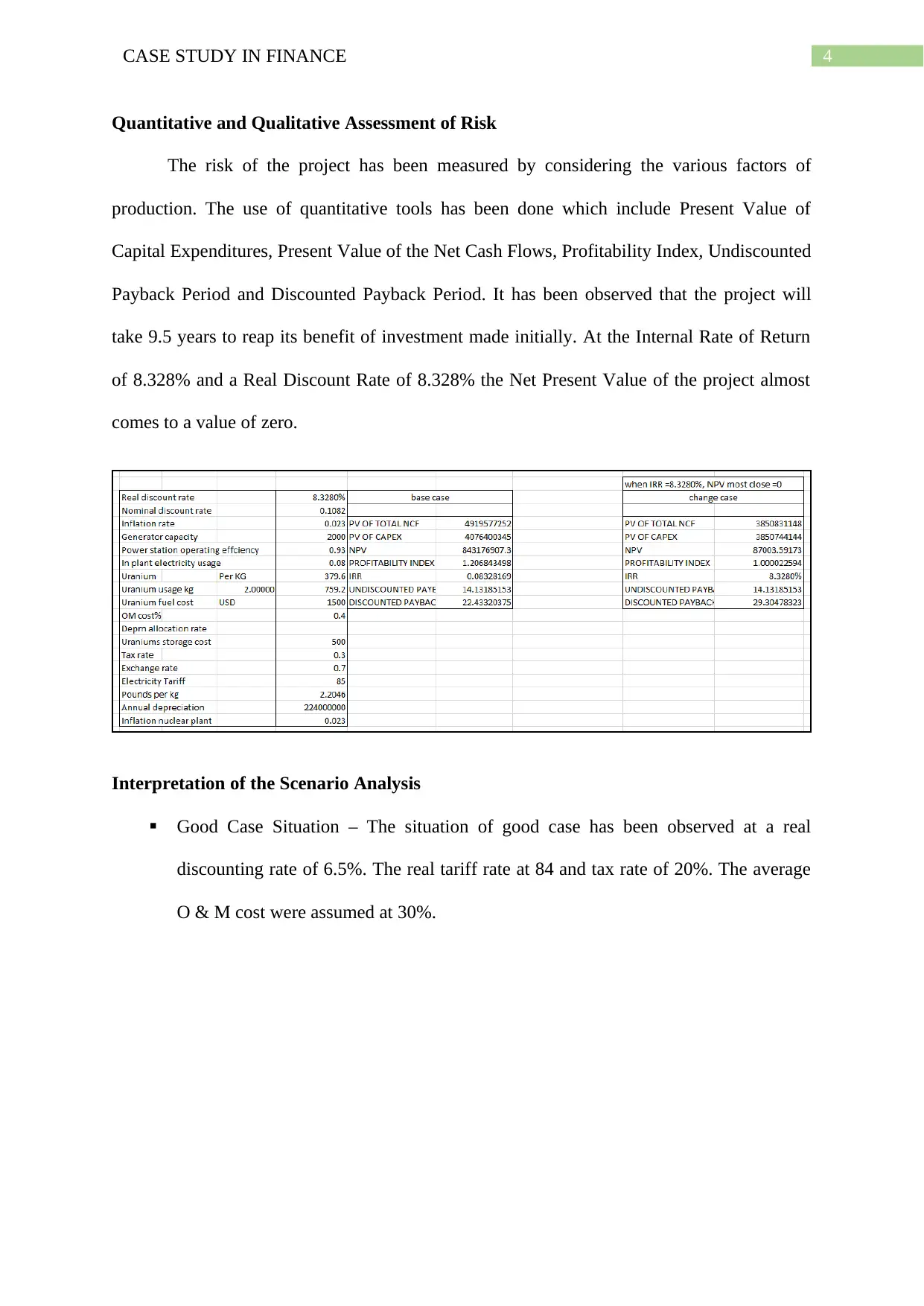
4CASE STUDY IN FINANCE
Quantitative and Qualitative Assessment of Risk
The risk of the project has been measured by considering the various factors of
production. The use of quantitative tools has been done which include Present Value of
Capital Expenditures, Present Value of the Net Cash Flows, Profitability Index, Undiscounted
Payback Period and Discounted Payback Period. It has been observed that the project will
take 9.5 years to reap its benefit of investment made initially. At the Internal Rate of Return
of 8.328% and a Real Discount Rate of 8.328% the Net Present Value of the project almost
comes to a value of zero.
Interpretation of the Scenario Analysis
Good Case Situation – The situation of good case has been observed at a real
discounting rate of 6.5%. The real tariff rate at 84 and tax rate of 20%. The average
O & M cost were assumed at 30%.
Quantitative and Qualitative Assessment of Risk
The risk of the project has been measured by considering the various factors of
production. The use of quantitative tools has been done which include Present Value of
Capital Expenditures, Present Value of the Net Cash Flows, Profitability Index, Undiscounted
Payback Period and Discounted Payback Period. It has been observed that the project will
take 9.5 years to reap its benefit of investment made initially. At the Internal Rate of Return
of 8.328% and a Real Discount Rate of 8.328% the Net Present Value of the project almost
comes to a value of zero.
Interpretation of the Scenario Analysis
Good Case Situation – The situation of good case has been observed at a real
discounting rate of 6.5%. The real tariff rate at 84 and tax rate of 20%. The average
O & M cost were assumed at 30%.
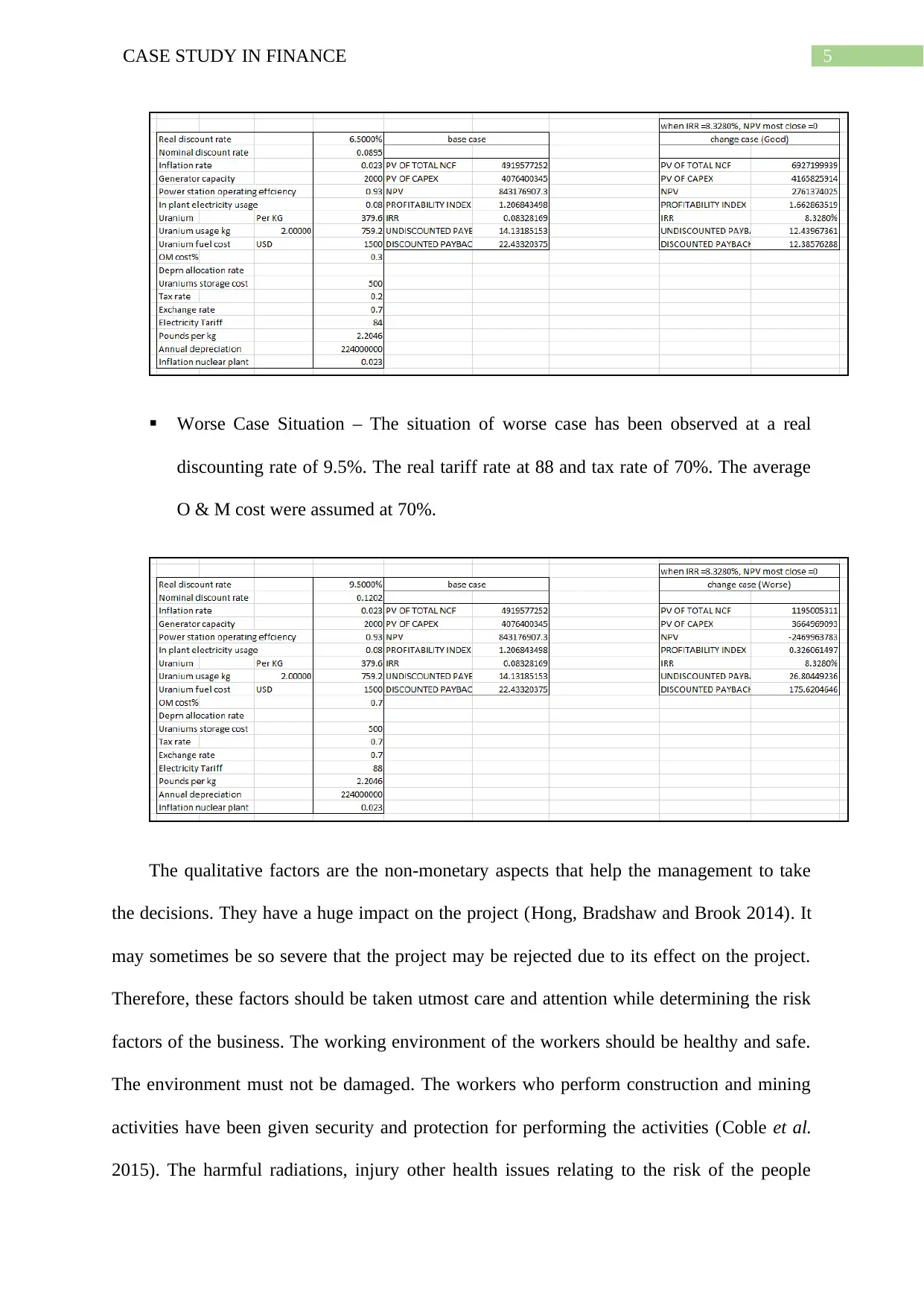
5CASE STUDY IN FINANCE
Worse Case Situation – The situation of worse case has been observed at a real
discounting rate of 9.5%. The real tariff rate at 88 and tax rate of 70%. The average
O & M cost were assumed at 70%.
The qualitative factors are the non-monetary aspects that help the management to take
the decisions. They have a huge impact on the project (Hong, Bradshaw and Brook 2014). It
may sometimes be so severe that the project may be rejected due to its effect on the project.
Therefore, these factors should be taken utmost care and attention while determining the risk
factors of the business. The working environment of the workers should be healthy and safe.
The environment must not be damaged. The workers who perform construction and mining
activities have been given security and protection for performing the activities (Coble et al.
2015). The harmful radiations, injury other health issues relating to the risk of the people
Worse Case Situation – The situation of worse case has been observed at a real
discounting rate of 9.5%. The real tariff rate at 88 and tax rate of 70%. The average
O & M cost were assumed at 70%.
The qualitative factors are the non-monetary aspects that help the management to take
the decisions. They have a huge impact on the project (Hong, Bradshaw and Brook 2014). It
may sometimes be so severe that the project may be rejected due to its effect on the project.
Therefore, these factors should be taken utmost care and attention while determining the risk
factors of the business. The working environment of the workers should be healthy and safe.
The environment must not be damaged. The workers who perform construction and mining
activities have been given security and protection for performing the activities (Coble et al.
2015). The harmful radiations, injury other health issues relating to the risk of the people
⊘ This is a preview!⊘
Do you want full access?
Subscribe today to unlock all pages.

Trusted by 1+ million students worldwide
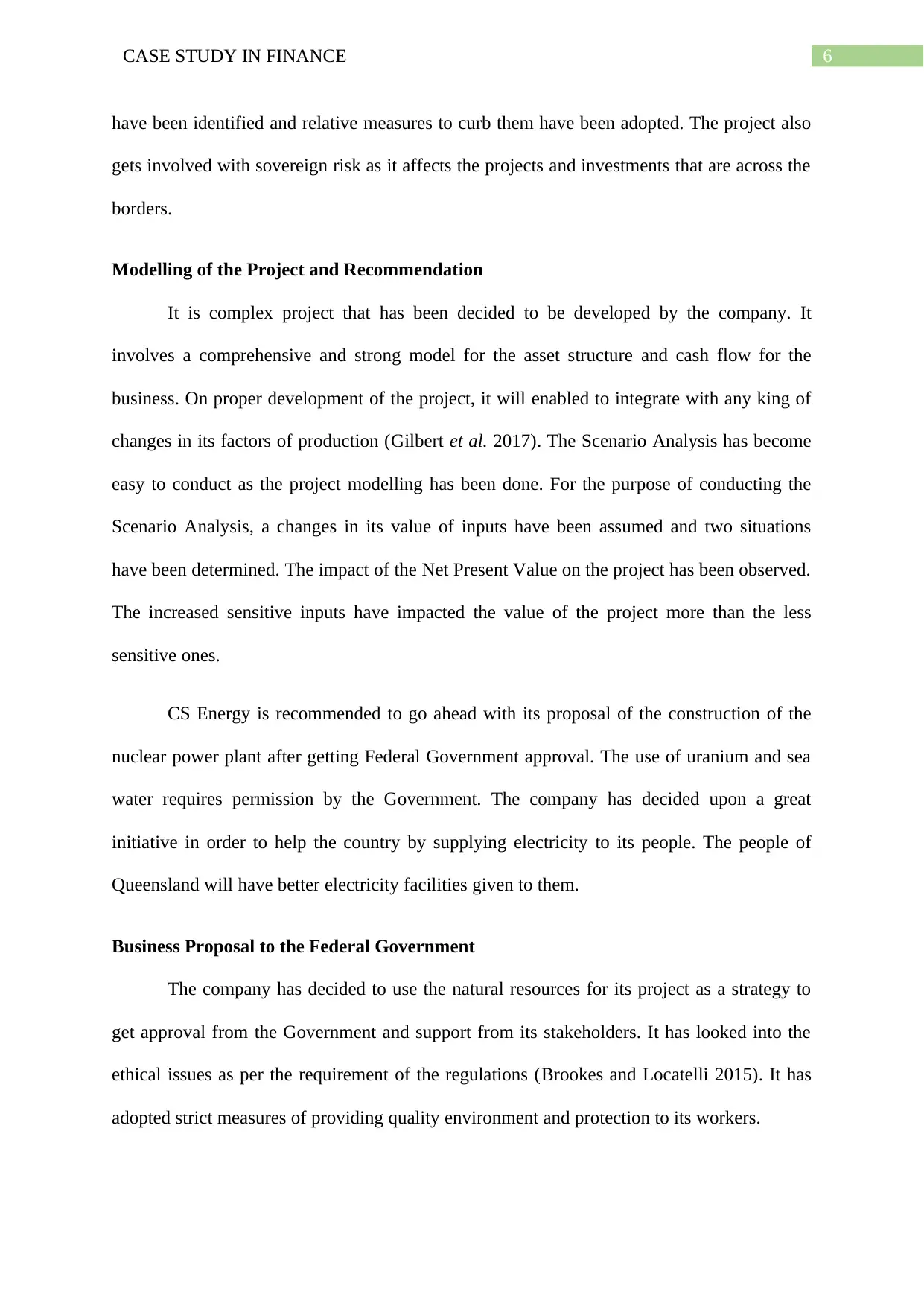
6CASE STUDY IN FINANCE
have been identified and relative measures to curb them have been adopted. The project also
gets involved with sovereign risk as it affects the projects and investments that are across the
borders.
Modelling of the Project and Recommendation
It is complex project that has been decided to be developed by the company. It
involves a comprehensive and strong model for the asset structure and cash flow for the
business. On proper development of the project, it will enabled to integrate with any king of
changes in its factors of production (Gilbert et al. 2017). The Scenario Analysis has become
easy to conduct as the project modelling has been done. For the purpose of conducting the
Scenario Analysis, a changes in its value of inputs have been assumed and two situations
have been determined. The impact of the Net Present Value on the project has been observed.
The increased sensitive inputs have impacted the value of the project more than the less
sensitive ones.
CS Energy is recommended to go ahead with its proposal of the construction of the
nuclear power plant after getting Federal Government approval. The use of uranium and sea
water requires permission by the Government. The company has decided upon a great
initiative in order to help the country by supplying electricity to its people. The people of
Queensland will have better electricity facilities given to them.
Business Proposal to the Federal Government
The company has decided to use the natural resources for its project as a strategy to
get approval from the Government and support from its stakeholders. It has looked into the
ethical issues as per the requirement of the regulations (Brookes and Locatelli 2015). It has
adopted strict measures of providing quality environment and protection to its workers.
have been identified and relative measures to curb them have been adopted. The project also
gets involved with sovereign risk as it affects the projects and investments that are across the
borders.
Modelling of the Project and Recommendation
It is complex project that has been decided to be developed by the company. It
involves a comprehensive and strong model for the asset structure and cash flow for the
business. On proper development of the project, it will enabled to integrate with any king of
changes in its factors of production (Gilbert et al. 2017). The Scenario Analysis has become
easy to conduct as the project modelling has been done. For the purpose of conducting the
Scenario Analysis, a changes in its value of inputs have been assumed and two situations
have been determined. The impact of the Net Present Value on the project has been observed.
The increased sensitive inputs have impacted the value of the project more than the less
sensitive ones.
CS Energy is recommended to go ahead with its proposal of the construction of the
nuclear power plant after getting Federal Government approval. The use of uranium and sea
water requires permission by the Government. The company has decided upon a great
initiative in order to help the country by supplying electricity to its people. The people of
Queensland will have better electricity facilities given to them.
Business Proposal to the Federal Government
The company has decided to use the natural resources for its project as a strategy to
get approval from the Government and support from its stakeholders. It has looked into the
ethical issues as per the requirement of the regulations (Brookes and Locatelli 2015). It has
adopted strict measures of providing quality environment and protection to its workers.
Paraphrase This Document
Need a fresh take? Get an instant paraphrase of this document with our AI Paraphraser
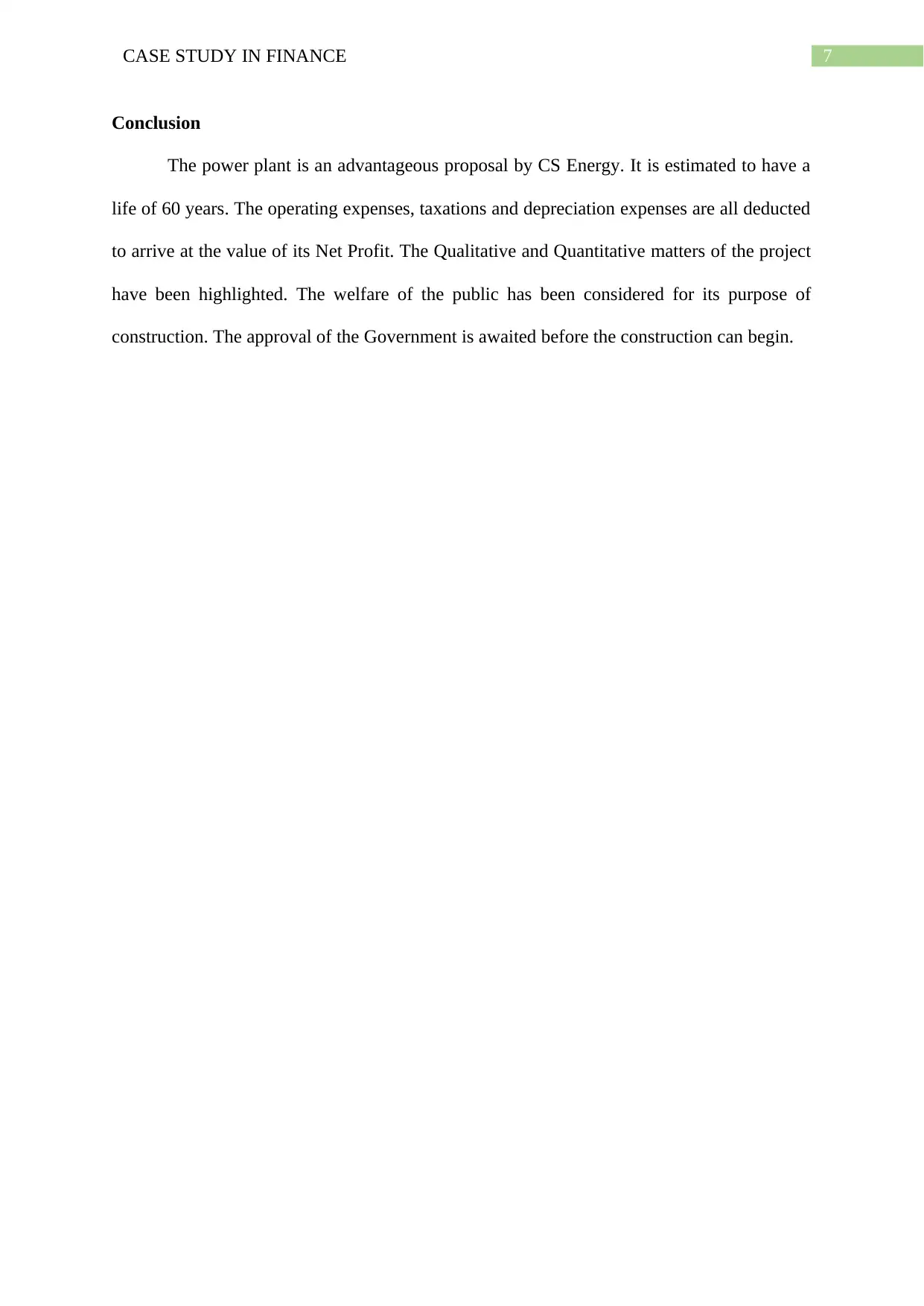
7CASE STUDY IN FINANCE
Conclusion
The power plant is an advantageous proposal by CS Energy. It is estimated to have a
life of 60 years. The operating expenses, taxations and depreciation expenses are all deducted
to arrive at the value of its Net Profit. The Qualitative and Quantitative matters of the project
have been highlighted. The welfare of the public has been considered for its purpose of
construction. The approval of the Government is awaited before the construction can begin.
Conclusion
The power plant is an advantageous proposal by CS Energy. It is estimated to have a
life of 60 years. The operating expenses, taxations and depreciation expenses are all deducted
to arrive at the value of its Net Profit. The Qualitative and Quantitative matters of the project
have been highlighted. The welfare of the public has been considered for its purpose of
construction. The approval of the Government is awaited before the construction can begin.
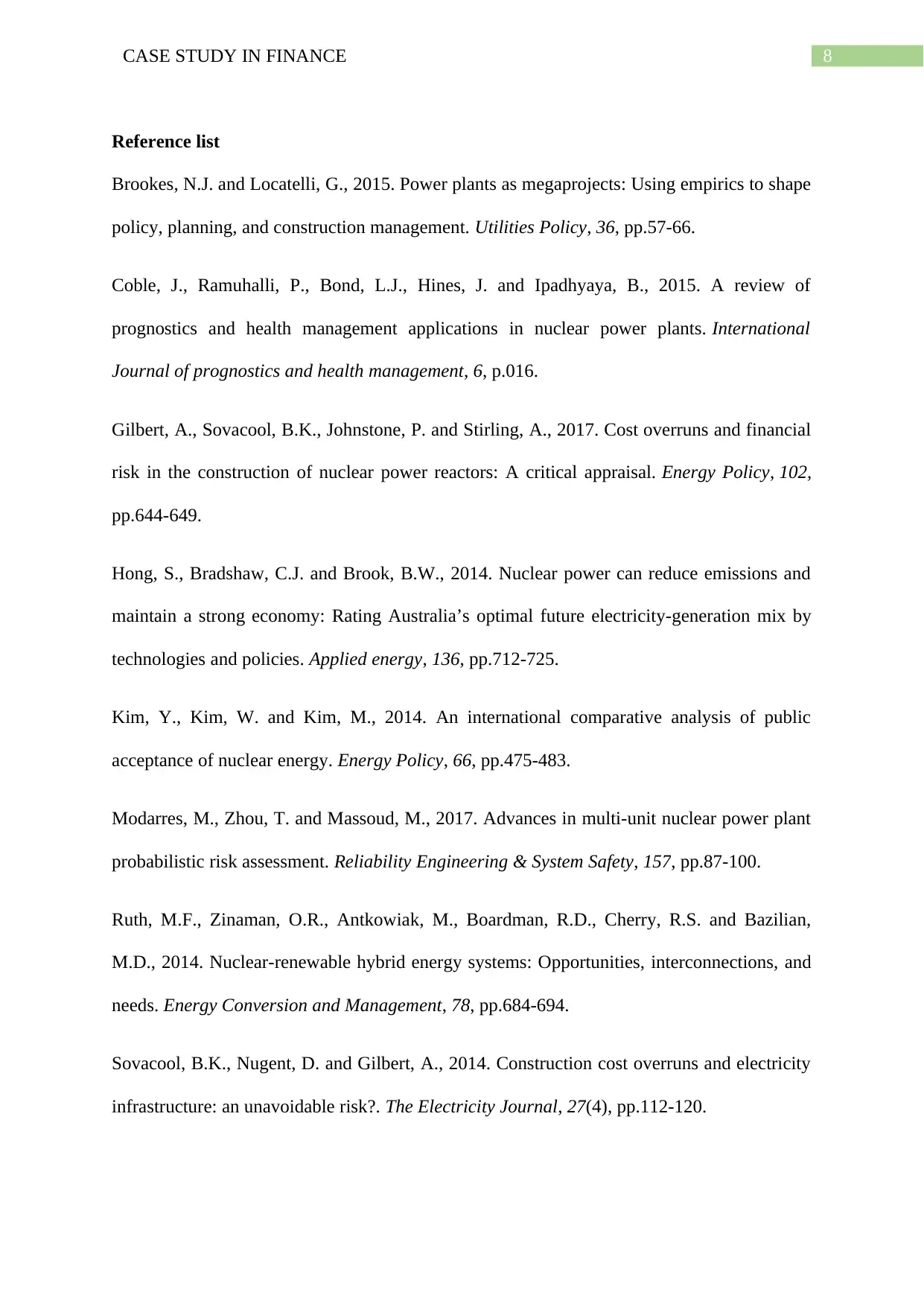
8CASE STUDY IN FINANCE
Reference list
Brookes, N.J. and Locatelli, G., 2015. Power plants as megaprojects: Using empirics to shape
policy, planning, and construction management. Utilities Policy, 36, pp.57-66.
Coble, J., Ramuhalli, P., Bond, L.J., Hines, J. and Ipadhyaya, B., 2015. A review of
prognostics and health management applications in nuclear power plants. International
Journal of prognostics and health management, 6, p.016.
Gilbert, A., Sovacool, B.K., Johnstone, P. and Stirling, A., 2017. Cost overruns and financial
risk in the construction of nuclear power reactors: A critical appraisal. Energy Policy, 102,
pp.644-649.
Hong, S., Bradshaw, C.J. and Brook, B.W., 2014. Nuclear power can reduce emissions and
maintain a strong economy: Rating Australia’s optimal future electricity-generation mix by
technologies and policies. Applied energy, 136, pp.712-725.
Kim, Y., Kim, W. and Kim, M., 2014. An international comparative analysis of public
acceptance of nuclear energy. Energy Policy, 66, pp.475-483.
Modarres, M., Zhou, T. and Massoud, M., 2017. Advances in multi-unit nuclear power plant
probabilistic risk assessment. Reliability Engineering & System Safety, 157, pp.87-100.
Ruth, M.F., Zinaman, O.R., Antkowiak, M., Boardman, R.D., Cherry, R.S. and Bazilian,
M.D., 2014. Nuclear-renewable hybrid energy systems: Opportunities, interconnections, and
needs. Energy Conversion and Management, 78, pp.684-694.
Sovacool, B.K., Nugent, D. and Gilbert, A., 2014. Construction cost overruns and electricity
infrastructure: an unavoidable risk?. The Electricity Journal, 27(4), pp.112-120.
Reference list
Brookes, N.J. and Locatelli, G., 2015. Power plants as megaprojects: Using empirics to shape
policy, planning, and construction management. Utilities Policy, 36, pp.57-66.
Coble, J., Ramuhalli, P., Bond, L.J., Hines, J. and Ipadhyaya, B., 2015. A review of
prognostics and health management applications in nuclear power plants. International
Journal of prognostics and health management, 6, p.016.
Gilbert, A., Sovacool, B.K., Johnstone, P. and Stirling, A., 2017. Cost overruns and financial
risk in the construction of nuclear power reactors: A critical appraisal. Energy Policy, 102,
pp.644-649.
Hong, S., Bradshaw, C.J. and Brook, B.W., 2014. Nuclear power can reduce emissions and
maintain a strong economy: Rating Australia’s optimal future electricity-generation mix by
technologies and policies. Applied energy, 136, pp.712-725.
Kim, Y., Kim, W. and Kim, M., 2014. An international comparative analysis of public
acceptance of nuclear energy. Energy Policy, 66, pp.475-483.
Modarres, M., Zhou, T. and Massoud, M., 2017. Advances in multi-unit nuclear power plant
probabilistic risk assessment. Reliability Engineering & System Safety, 157, pp.87-100.
Ruth, M.F., Zinaman, O.R., Antkowiak, M., Boardman, R.D., Cherry, R.S. and Bazilian,
M.D., 2014. Nuclear-renewable hybrid energy systems: Opportunities, interconnections, and
needs. Energy Conversion and Management, 78, pp.684-694.
Sovacool, B.K., Nugent, D. and Gilbert, A., 2014. Construction cost overruns and electricity
infrastructure: an unavoidable risk?. The Electricity Journal, 27(4), pp.112-120.
⊘ This is a preview!⊘
Do you want full access?
Subscribe today to unlock all pages.

Trusted by 1+ million students worldwide
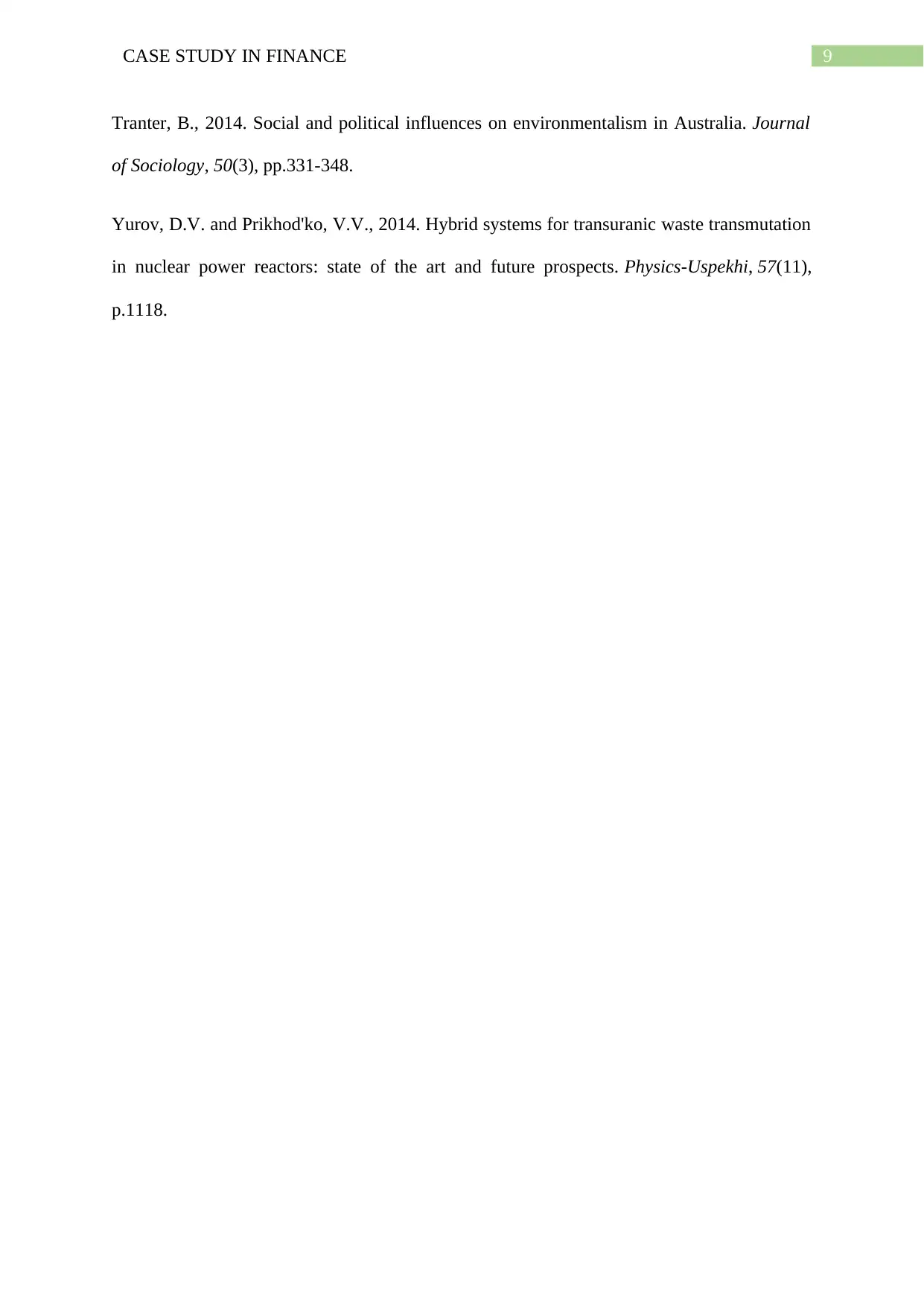
9CASE STUDY IN FINANCE
Tranter, B., 2014. Social and political influences on environmentalism in Australia. Journal
of Sociology, 50(3), pp.331-348.
Yurov, D.V. and Prikhod'ko, V.V., 2014. Hybrid systems for transuranic waste transmutation
in nuclear power reactors: state of the art and future prospects. Physics-Uspekhi, 57(11),
p.1118.
Tranter, B., 2014. Social and political influences on environmentalism in Australia. Journal
of Sociology, 50(3), pp.331-348.
Yurov, D.V. and Prikhod'ko, V.V., 2014. Hybrid systems for transuranic waste transmutation
in nuclear power reactors: state of the art and future prospects. Physics-Uspekhi, 57(11),
p.1118.
1 out of 10
Related Documents
Your All-in-One AI-Powered Toolkit for Academic Success.
+13062052269
info@desklib.com
Available 24*7 on WhatsApp / Email
![[object Object]](/_next/static/media/star-bottom.7253800d.svg)
Unlock your academic potential
Copyright © 2020–2025 A2Z Services. All Rights Reserved. Developed and managed by ZUCOL.





